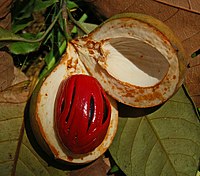
Photo from wikipedia
Spinach is a common vegetable, and dioecy is maintained by a pair of XY sex chromosomes. Due to limited genomic resources and its highly repetitive genome, limited studies were conducted… Click to show full abstract
Spinach is a common vegetable, and dioecy is maintained by a pair of XY sex chromosomes. Due to limited genomic resources and its highly repetitive genome, limited studies were conducted to investigate the genomic landscape of the region near sex-determining loci. In this study, we screened the structure variations (SVs) between Y-linked contigs and a 1.78-Mb X scaffold (Super_scaffold 66), which enabled the development of 12 sex co-segregating DNA markers. These markers were tested in one F1 mapping population and 40 spinach accessions, which comprised 692 individual plants with the strong sex linkage pattern. In addition, we found that Super_scaffold 66 was highly repetitive along with the enriched LTR-RTs insertions and decreased microsatellite distribution compared with the rest genome, which matches extremely low gene density featured by only nine annotated genes. Synteny analysis between Y contigs and Superscaffold_66 revealed a 340-Kb accumulative Y contig (non-continuous) and a 500-Kb X counterpart along with SVs and wide-spread tandem duplications. Among the nine genes, one ABC transporter gene revealed noticeable SVs between Y contig and X counterpart, as an approximate 5-Kb recent Gypsy LTR-RT insertion in the Y-linked allele, but not the X allele. The gene paucity, SVs, and sex-linked polymorphisms attributed to the recombination suppression. We proposed that Super_scaffold 66 is part of the non-recombining region containing the sex determination genes. The spread of 12 sex co-segregating markers from this 1.78 Mb genomic region indicated the existence and expansion of sex determination region during progression of the Y chromosome.
Journal Title: Plant reproduction
Year Published: 2021
Link to full text (if available)
Share on Social Media: Sign Up to like & get
recommendations!